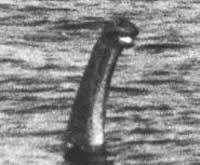Loch Ness monster does a bad turn for tourism

Skepticism about Loch Ness monster’s existence could threaten tourism in Scotland.
There have only been two reports of sightings this year, compared to three in 2006 and much lower than a decade ago, when the annual number sightings was consistently in the double digits, The Times newspaper said Saturday.
"It's becoming a potential crisis," said Mikko Takala, 39, a founding member of the Loch Ness Monster Fan Club who runs four webcams on the lake's north shore.
Scottish Tourism officials were not immediately available to comment.
Loch Ness - the largest and deepest inland expanse of water in Britain - is surrounded by myth and mystery. About 750 feet (230 meters) to the bottom, the loch - the Scottish word for "lake" - is deeper than the North Sea.
There have been more than 4,000 purported sightings of a creature - affectionately dubbed "Nessie" - since a surgeon vacationing at the lake in the 1930s released a photo allegedly capturing the legendary monster on film.
Since then, Nessie has been a key tourism draw, bringing an estimated 6 million pounds (EUR8.6 million, US$3 million) a year into the Scottish Highlands, according to The Times.
The faithful have speculated whether Nessie is a completely unknown species; a sturgeon, even though they have not been native to Scotland's waters for many years; or even a last surviving dinosaur.
In the age of digital cameras, webcams and video recorders, it is surprising that the number of reported sightings is falling.
Adrian Shine, 58, a naturalist who has investigated the mystery of the monster for 20 years, thinks the trend shows the world has become more skeptical.
"I think we live in a more pragmatic age, and that people are becoming more aware of the sort of illusions that can occur on water," he said.
Subscribe to Pravda.Ru Telegram channel, Facebook, RSS!





